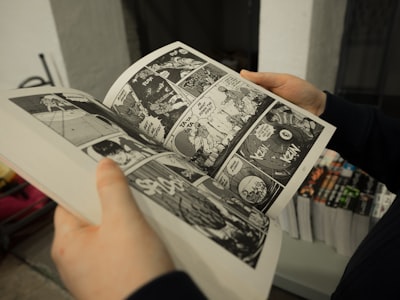If you’re a fan of comics, you’ve probably come across the terms “manga” and “manhwa” at some point.
These two types of East Asian comics have been gaining immense popularity in recent years, captivating readers around the world. While they may seem similar at first glance, there are key differences between manga and manhwa that are worth exploring.
In this article, we will delve into the origins, visual styles, reading formats, and current trends of manga and manhwa.
Table of Contents
The Key Differences Between Manga and Manhwa
While manga and manhwa share some similarities, there are key differences that set them apart. Let’s summarize these differences:
Country of Origin: Manga originates from Japan, while manhwa is from South Korea. Reading Format: Manga is read from right to left, top to bottom, while manhwa is read from left to right, top to bottom.
Visual Style: Manga often features stylized characters with large eyes, while manhwa tends to have more realistic character designs.
Color: Manga is predominantly black and white, while manhwa embraces full-color illustrations, especially in webtoon format.
Publication: Manga is traditionally serialized in magazines before being compiled into volumes, while manhwa webtoons are released digitally on platforms like LINE Webtoon.
Genres and Themes: While both manga and manhwa cover a wide range of genres, they may have different thematic focuses and storytelling approaches.
Manga: The Japanese Comic Phenomenon

Manga, originating from Japan, is undoubtedly the most well-known and widely consumed form of East Asian comics. With its unique art style and captivating storytelling, manga has captured the hearts of millions of readers worldwide. The term “manga” is derived from the Japanese word for “comic,” and it encompasses a vast range of genres, from action-packed adventures to heartwarming slice-of-life stories.
Origins and Visual Style
The roots of manga can be traced back to the 12th century, but it was after World War II that the modern format of manga emerged. Pioneered by influential creators like Osamu Tezuka, the Godfather of Manga, manga developed its distinct visual style characterized by large, expressive eyes, dynamic action sequences, and a wide range of artistic techniques. While most manga is black and white, color illustrations are occasionally used for special occasions or cover pages.
Reading Format and Publication
One of the defining features of manga is its unique reading format. Unlike traditional Western comics, manga is read from right to left and top to bottom. This format can take some getting used to for readers unfamiliar with manga, but it quickly becomes intuitive and adds to the immersive reading experience.

Manga is typically serialized in weekly or monthly magazines, such as Shonen Jump or Shueisha, before being compiled into individual volumes. This serialization allows for ongoing stories that can span several years or even decades.
Popular Manga Genres
The world of manga offers a diverse range of genres to suit every reader’s taste. Here are some popular manga genres:
- Shonen: Targeted primarily at adolescent boys, shonen manga focuses on action, adventure, and often incorporates elements of fantasy and science fiction. Examples include Naruto, One Piece, and Dragon Ball.
- Shoujo: Aimed at teenage girls, shoujo manga explores themes of romance, friendship, and personal growth. These stories often feature delicate artwork, expressive emotions, and compelling character relationships. Popular examples include “Fruits Basket,” “Sailor Moon,” and “Cardcaptor Sakura.”
- Seinen: Geared towards young adult and adult male readers, seinen manga delves into mature themes, complex characters, and thought-provoking narratives. It covers a wide range of genres, including drama, psychological thriller, and science fiction. Notable examples include “Berserk,” “Monster,” and “Death Note.”
- Josei: Similar to seinen manga, josei targets young adult and adult female readers. It explores realistic and often mature themes, focusing on the complexities of relationships, career struggles, and self-discovery. Popular josei manga includes “Nana,” “Honey and Clover,” and “Princess Jellyfish.”
Manhwa: The Unique Korean Comic Tradition
While manga may be the dominant force in the world of East Asian comics, manhwa, originating from South Korea, has been steadily gaining recognition and popularity. Manhwa possesses its own distinct style and storytelling traditions that set it apart from manga.

Historical and Cultural Influences
The history of manhwa is intricately tied to the political and social landscape of Korea. Under Japanese occupation in the early 20th century, manhwa served as a means of resistance and commentary on the political situation. However, government censorship and control hindered the growth of manhwa until the mid-20th century. Since then, manhwa has flourished, reflecting the unique cultural experiences and perspectives of Korean creators.
Visual Style and Colorful Art
Manhwa exhibits a different visual style compared to manga. While both share the use of expressive characters, manhwa generally features more realistic and less stylized artwork. The emphasis is placed on capturing facial expressions, emotions, and detailed backgrounds. Unlike manga, manhwa often embraces full-color illustrations, especially in its popular digital format known as webtoons.
Webtoons and Digital Revolution
One of the significant developments in the manhwa industry is the rise of webtoons. Webtoons are digital comics optimized for reading on mobile devices, featuring vertical scrolling and full-color panels. This format has revolutionized the way manhwa is consumed, making it easily accessible to readers around the world. Platforms like Lezhin and LINE Webtoon have played a crucial role in the popularity and distribution of manhwa webtoons.
Manhwa Genres and Themes
Manhwa covers a wide range of genres, catering to diverse audiences. Some popular manhwa genres include:
- Action: Manhwa action titles often feature intense fight scenes, supernatural powers, and epic adventures. Examples include “The Breaker,” “The God of High School,” and “Tower of God.”
Romance: Manhwa romance stories explore various aspects of love, relationships, and personal growth. They often incorporate elements of drama, comedy, and fantasy. Notable romance manhwa include “True Beauty,” “Cheese in the Trap,” and “My ID is Gangnam Beauty.”
- Fantasy: Fantasy manhwa transports readers to imaginative worlds filled with magic, mythical creatures, and epic quests. Titles like “Solo Leveling,” “The Beginning After the End,” and “The Legendary Moonlight Sculptor” have gained immense popularity.
- Slice-of-Life: Manhwa slice-of-life stories focus on everyday experiences, relationships, and personal growth. They offer a glimpse into the lives of relatable characters and explore themes of friendship, family, and self-discovery. Noteworthy examples include “The Sound of Your Heart,” “Yumi’s Cells,” and “Oh! Holy.”
Conclusion
In conclusion, manga and manhwa are two distinct forms of East Asian comics that have captivated readers around the world. Manga, originating from Japan, boasts a rich history, unique visual style, and a wide variety of genres. Manhwa, originating from South Korea, offers its own visual style, storytelling traditions, and the innovative format of webtoons. Understanding the key differences between manga and manhwa allows readers to appreciate and explore the diverse world of East Asian comics. So whether you find yourself immersed in the action-packed stories of manga or the colorful webtoons of manhwa, both art forms offer endless opportunities for entertainment and creative expression.
Additional Information: It is worth noting that while manga and manhwa have their respective origins and cultural influences, the lines between the two can blur at times. With the global popularity of both forms, creators and audiences are increasingly influencing and inspiring one another, resulting in fascinating cross-pollination of ideas and styles. This dynamic exchange contributes to the richness and diversity of the East Asian comics landscape.
